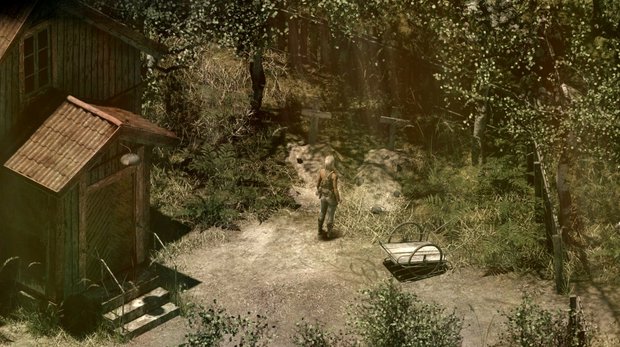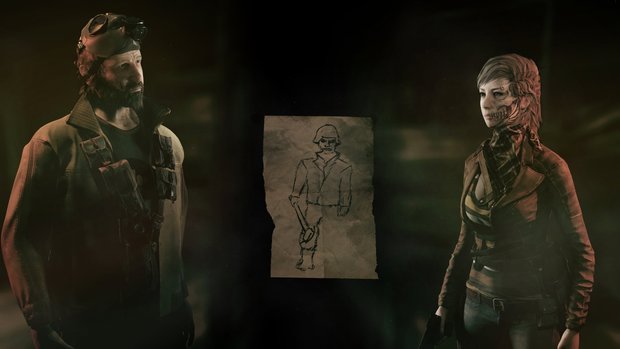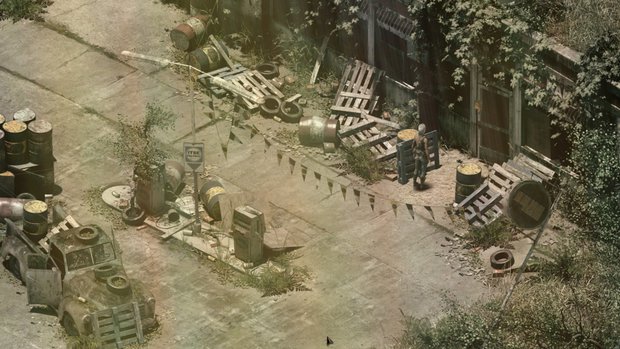Rauniot review

- 0 Comments
From the ruins of apocalyptic calamity rises a grimly beautiful, compelling isometric adventure
Generally speaking, I'm drawn to the light, sunshine and rainbows end of the narrative spectrum. I am a card-carrying member of the happy endings fan club, drawn to stories where, just this once, everybody lives. Rauniot is not that. In fact, it's as unrelentingly dark and bleak as the Nordic winter, and yet I couldn't look away. Finnish studio Act Normal's debut may be determined to snuff out any brief ember of hope almost as soon as it appears, but it also presents an unflinchingly honest portrayal of post-apocalyptic life, of people becoming their best and worst selves in a world gone mad. The otherwise logical puzzles are slightly undermined by some frustrating pixel hunting and the set-up (location aside) is not the most original, but the oppressive atmosphere and stoic characters make for a memorable experience.
In an alternate 1975, a massive natural disaster nearly wiped us out. We don't know what it was, exactly, but in the wake of the floods, wars, and nuclear meltdowns that followed, only scattered pockets of survivors remained, huddling together for protection in remote places such as (in this case) Lapland in northern Finland. They live by scavenging, eating anything edible, and repurposing the rest into ramshackle housing and machinery. Think Mad Max, but with better coffee. (Yes, in a world where humanity has been reduced to eating dog food and occasional cannibalism, the Finns somehow still have a coffee supply. Go figure!)

It's now 1981, and rumours have been spreading of a nuclear-powered train, known as "Fission on Rails," that was late in development when the world went sideways. Aino's partner Toivo has already gone missing in search of it, and now it's up to her to track down both him and the train, starting at a remote and desolate gas station. Along the way, she stumbles across a camo-clad gay survivalist with a thing for romance novels, an orphan girl who's turned a former military research complex into her own private play space, and a Sami commune whose nomadic wilderness lifestyle has changed surprisingly little. With her scary skull face tattoos, piercings, and combat gear, Aino has proven she’s tough merely by surviving this long. And that’s just as well, because she gets captured, strung up and imprisoned by virtually everyone she meets, sometimes for their protection and sometimes simply for their own twisted amusement. As she searches for the train, she also uncovers the quiet tragedy that tore a tiny remote community apart and what little faith she had left in human nature is shattered. Sometimes, all you can do is endure, and that has to be enough.
Rauniot’s world, presented in photorealistic, isometric 3D, is intricately crafted, melancholically beautiful at times, but not exactly vibrant. Granted, sunshine and bright spring flowers wouldn't exactly fit the mood, but here we're treated to an unrelenting blend of mud brown, forest green, and industrial grey, with just an occasional splash of warning beacon red. It's lovingly and intricately rendered, with grass and trees waving in the wind, clouds of dust and insects blowing by, and streams gurgling past, but it's still a mix of dense woods, scrubland, and a variety of slowly rusting underground bunkers. Not the most varied, then, but powerfully, stiflingly atmospheric just the same. As a side note, the loading screens that appear when you switch areas are filled with a variety of charming hand-drawn concept art, helping to make the (weirdly long) waits between screens much more bearable.
The soundscape really adds to the sense of remoteness and isolation, too, as it's dominated by rustling branches, the squeak of long-unoiled machinery, and mournful bird calls. Underneath that, the music is slow, sad and mostly ambient; fitting, if not especially memorable. The game is fully voiced, but only in Finnish (with English subtitles). The actors nonetheless come across as resigned but resolute, and very occasionally amused, which did add something, even to my non-Finnish-speaking ears. That said, I found conversations a little unsettling: the scene switches to show just the two speakers, but while their lips and heads move, their bodies do not. Or rather, they do, but only to shift slightly as they breathe. The head movements also look robotically unnatural, making me wish they'd just settled for talking character portraits instead.
Rauniot very much leans into the retro 80s vibe, even presenting the main menu as the screen of a vintage terminal, complete with a floppy disk drive for your save games. There's an in-game manual, too, represented as a leaflet left resting above the terminal's keyboard. As someone who's old enough to remember the days when games came in physical boxes with printed manuals, it gave me a powerful whiff of nostalgia. It's thirteen pages long, taking you through the game's backstory and everything you could want to know about how to play. You'd better pay attention, too, as the interface (slick as it is once you've got the hang of it) is a tad non-standard.

First off, everything's controlled with the mouse, with no keyboard shortcuts (other than Esc to skip cutscenes) and no controller support. (A tad ironic, that, given all the keyboard-driven terminals you come across in-game.) Movement is standard point-and-click, with double-click to run, but there's no obvious sign of your inventory or any other icons. In order to find those, you instead have to right-click, which brings up a view of Aino's backpack, utility belt and journal. Clicking on the utility belt shows your inventory, while clicking on the backpack sends you back to the main menu screen. Finally, her journal turns out to be a folder/scrapbook affair that collates all the useful information she's uncovered and includes a rough map that fills out with improvised sticky notes showing the locations she's explored. Clicking on these enables fast travel back and forth, which is a great help during some of the mid-game puzzles. Aino's quite the artist, too: when she gathers new information, the journal's pages slowly fill up with beautifully drawn portraits of the people she meets.
The game’s incredibly detailed scenes, as striking as they are, are also unfortunately the source of its greatest frustration. Many of the objects you're looking for are quite small (literally just a handful of pixels in some cases), and blend in perfectly with all the other post-apocalyptic clutter. Mousing over an item does highlight it, but that just adds a subtle tint and a thin outline that looks great but is easy to miss, especially since some objects are either layered on top of other ones or right next to exit hotspots. Often it was the accompanying sound effect that alerted me, not anything happening on-screen. I really, really missed not having a hotspot highlighter, especially when I had to find a tin of dog food to trade for generator parts. That doesn't sound so hard, until you realise that it's small and could be pretty much anywhere on the map – a map that is packed with empty cans that look identical. If the goal was to depict the survivors' tediously mundane daily grind, it succeeded, but I could have done without that much realism!
These niggles are especially unfortunate, as Rauniot’s puzzles are otherwise nicely done. You have to get generators up and running, finagle your way past a broken keypad, and even play signalwoman to manoeuver a (thankfully non-radioactive) train down the line. Everything's logical and fitting, tricky enough to be interesting without tipping over the line into puzzle box territory. You do have to trek back and forth quite a bit, especially to redirect your limited power supplies in an underground control room, but the fast travel system definitely takes the sting out of this. Aino also has a gun and, in a world where casual violence is part of everyday life, it can help her skip past a puzzle or two, provided she (and you) can live with the consequences. The game does a great job of handling the possibilities this creates, tweaking the narrative to keep you on course and leading to a few slightly different endings.
The story's not especially long, taking around 5-6 hours for a first playthrough but only a couple the second time around once you know what you're doing and where everything is. The plot itself is fairly low-key: Aino is no saviour coming to turn the tide for humanity in its long journey back to civilisation. Instead, this is a small, personal episode in a much larger story. Along the way, Aino also uncovers a web of jealousy and betrayal that has little to do with her main goal, but is much more interesting. Especially since it's slowly revealed through a hint here, an improvised grave there, and even a child's unsettling drawings, with the player left to put the pieces together. Appropriately, the ending brings a feeling of closure, but not victory or failure, and left me with a swirl of conflicting emotions.
Final Verdict
Rauniot is the full post-apocalyptic experience, for better and worse. The story is slight but delicately layered, the detailed isometric graphics are gorgeous in a very monochrome kind of way, and the soundscape really rams home the feeling of remote isolation. The characters too, in their quiet endurance and occasional dark humour, are more affecting than if they had screamed or sobbed. The practical challenges you face are also reasonable and logical, even if finding the items you need can be tricky. If you're a fan of Fallout or Mad Max-style sci-fi, though, and you're interested in something a little off the beaten track, it could be exactly what you're looking for. Just be sure to pack plenty of dog food and watch out for tripwires!
Hot take
Rauniot takes a familiar post-apocalyptic setting and adds some brutally relatable characters, a dash of Finnish eccentricity, and a little too much pixel hunting to create a low-key tale of betrayal, survival and resilience.
Pros
- Every scene is packed with detail and movement
- Atmospheric soundscape adds to the feeling of remoteness and isolation
- Distinctive characters with deep, interrelated backstories
- Grounded, logical puzzles
Cons
- Small objects against detailed backgrounds can be hard to spot
- Limited colour palette makes for a drab world
- A little short, even with quite a lot of backtracking (made bearable by fast travel)
Peter played Rauniot on PC using a review code provided by the game's publisher.










0 Comments
Want to join the discussion? Leave a comment as guest, sign in or register.
Leave a comment